|
Fall, 2023
Do you hear the cackle on the wind? The cawing crows? The croaks and groans?
Halloween season has officially arrived 🎃
This month, certain wildlife species come to the forefront. Crows, bats, and snakes are Halloween icons, decorating every nook and cranny. But these species don’t deserve the scary stereotype.
So to celebrate the season of scares, we’re breaking down some myths that surround our “spookier” wildlife species!
But before we get into all the Halloween fun, we have some exciting news to share!
The Nongame Wildlife Program has a new supervisor! Cynthia Osmundson retired this summer and Kristin Hall has taken the helm. Kristin has been with the Nongame Wildlife Program since 2018 as our State Wildlife Action Plan Coordinator. Before joining our program, she spent 10 years with Audubon building partnerships and collaborations for Important Bird Areas. Kristin brings incredible experience (and incredible costumes!) and we couldn’t be happier to have her as our new Nongame Wildlife Program Supervisor. |
|
 |
We’ve also created and hired a new supervisory position! Jessica Ruthenberg will lead our wildlife engagement and education efforts as the new Nongame Wildlife Program Engagement Supervisor. Jessica joins us from the Virginia Department of Wildlife Resources, where she was a Watchable Wildlife Biologist for over nine years. She holds a Masters in Natural Resources and the Environment from University of Michigan, with a dual-specialization in Conservation Biology and Environmental Behavior, Education, and Communication. We’re so excited to have Jessica and can’t wait to grow the engagement and education side of our program! |
|
 |

During Halloween, many of us dress up in costumes. But did you know that some of our snakes do too?
There are many non-venomous snake species that will mimic the iconic rattle of rattlesnakes to deter predators (like the bull snake pictured). But don’t be afraid! These snakes are harmless to humans.
In fact, only two of Minnesota’s native snake species are venomous, both of which are rattlesnakes. These rattlesnakes are very rare: in fact, the Massasauga hasn’t been confirmed in Minnesota for over 50 years! The timber rattlesnake is a threatened species and is only found in Minnesota’s bluff regions in the southeast. They’re generally docile and their first reaction to danger is to hide or flee from the threat.
You can learn more about Minnesota’s snakes in our “Snakes and Lizards of Minnesota” booklet
|
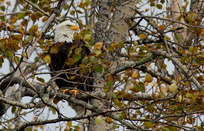
October isn’t all thrills and chills! Migration is still ongoing, with tundra swans, great blue herons, great white pelicans, osprey, and more flying south for the winter.
The Mississippi River and the Minnesota River are both migration highways and great places to visit for fall birding. But any water body is likely to host some migrating birds, so visit the rivers, ponds, lakes, and wetlands near you.
Many think of migration as species leaving Minnesota, but some migrate here! Snow buntings, golden eagles, snowy owls, and rough-legged hawks all migrate south to Minnesota for the winter. These species can be found all over the state, but you have the best chance of seeing them in northern Minnesota.
Photo taken by Jennifer Evens
|
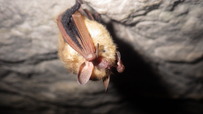
Don’t worry, this bat’s not a vampire in disguise!
Minnesota is home to eight different bat species, but none are vampire bats. These flying mammals aren’t interested in your blood or your hair. Minnesota’s bats have pretty good eyesight and will avoid humans while they hunt insects.
But we’d still discourage you from inviting them into your home. Both because bats belong outside and, well, you can never be too careful 🧛
|
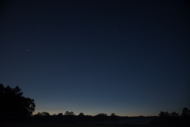
Embrace the season of darkness with some nocturnal walks!
Many animals are active at night, especially owls and bats. Take a friend, a flashlight, some reflective clothing, and head out right after dusk for your best chance to hear or see some nocturnal activity.
Stay quiet and use all your senses to try and identify what you’re noticing. Ask yourself: what am I hearing? What am I smelling? Do you notice any movement? Apps like Merlin are also great for identifying calls!
Make sure you’re staying safe as you search for nocturnal animals. Avoid busy roads and always wear reflective clothing so that you’re easy to spot. Many public parks and natural areas close at sunset, so confirm the hours before you leave.
|
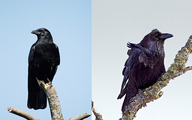
Crows and ravens are Halloween icons. They appear in many of our spookier stories, like “The Raven” by Edgar Allan Poe and Alfred Hitchcock’s film “The Birds”. Their calls echo over foggy landscapes and their black silhouette is frequently used to set a moody aesthetic.
But…what’s the difference between them?
Both are members of the Corvidae family. They’re both intelligent species and can live up to 15 years in the wild. Crows are smaller than ravens and roost in larger numbers. Crows can be found throughout Minnesota, while ravens tend to live in the northern forests. They also have different calls; crows have the classic “caw, caw, caw” while ravens have a call that sounds like a croaking frog.
Chet Meyers dives into more differences between crows and ravens in his article “Crow or Raven?” for the Minnesota Conservation Volunteer.
The crow (left) was taken by Michael Furtman and the raven (right) was taken by David Brislance, both photos pulled from the MCV article.
|
|
Have you ever wondered why some wildlife species are considered spooky while others aren’t? For example, why do we put up Halloween decorations of crows and not loons?
The National Wildlife Federation breaks down the origins of these spooky misconceptions (spoiler alert, a lot of it is actually based in old mythology!)
Photo taken by Shawn Marquez
|
|
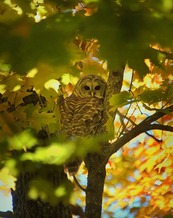 |
|